Evaluating Current Change Management Models in Today's Organizations
VerifiedAdded on 2023/06/10
|11
|2774
|487
Report
AI Summary
This report outlines and explains the significance and role of change management in today's organizations. It discusses change management theories, including Lewin's change management model, Kotter's 8-step change model, and the ADKAR model. The report analyzes current research literature, interprets its meaning for modern organizations, and draws conclusions about the validity of current change models. Real-world examples from companies like Nokia and Coca-Cola illustrate the application of these theories. Recommendations for enhancing change management processes within organizations are also provided, emphasizing employee engagement, team strategy, and effective communication. The report concludes that change management is essential for gaining a competitive advantage and improving organizational goodwill.
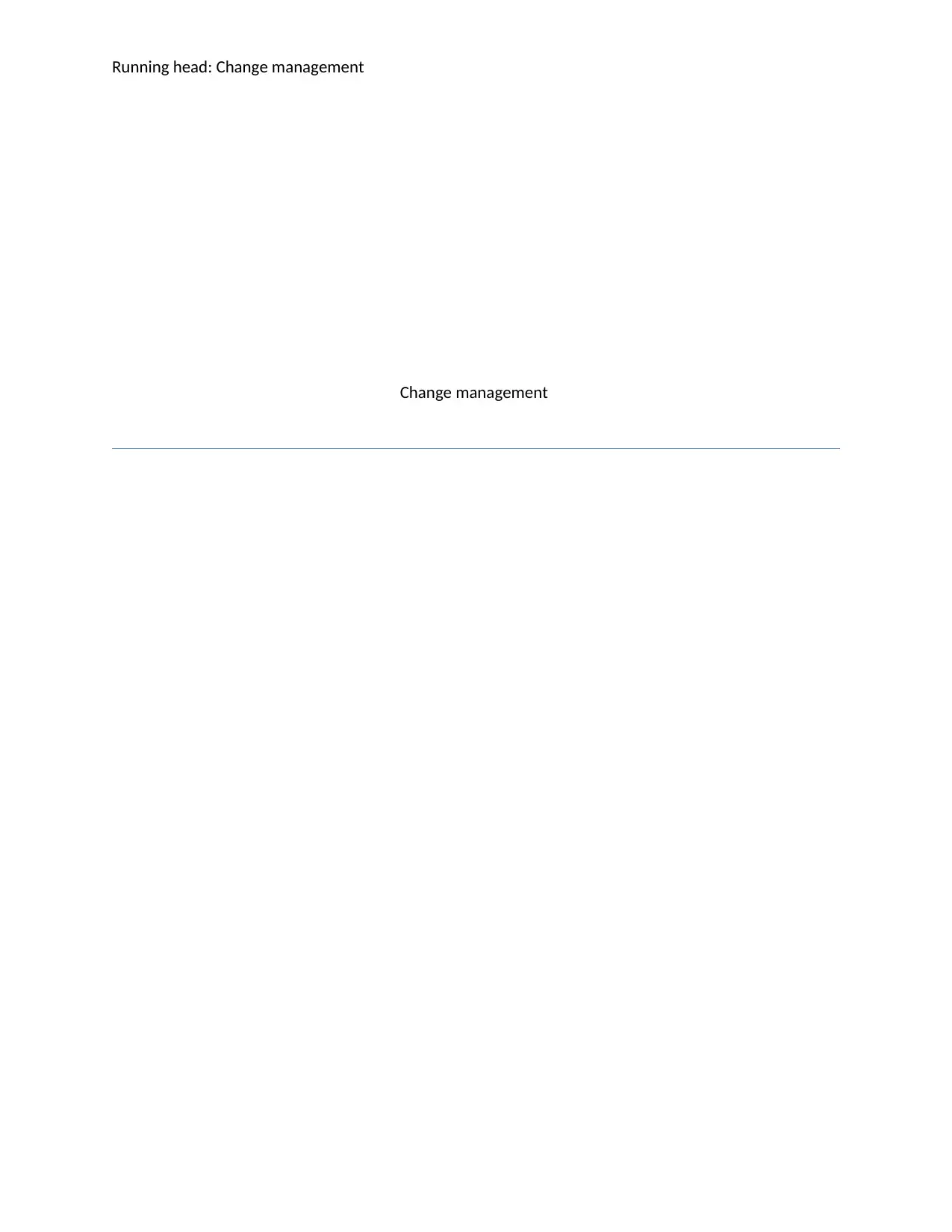
Running head: Change management
Change management
Change management
Paraphrase This Document
Need a fresh take? Get an instant paraphrase of this document with our AI Paraphraser
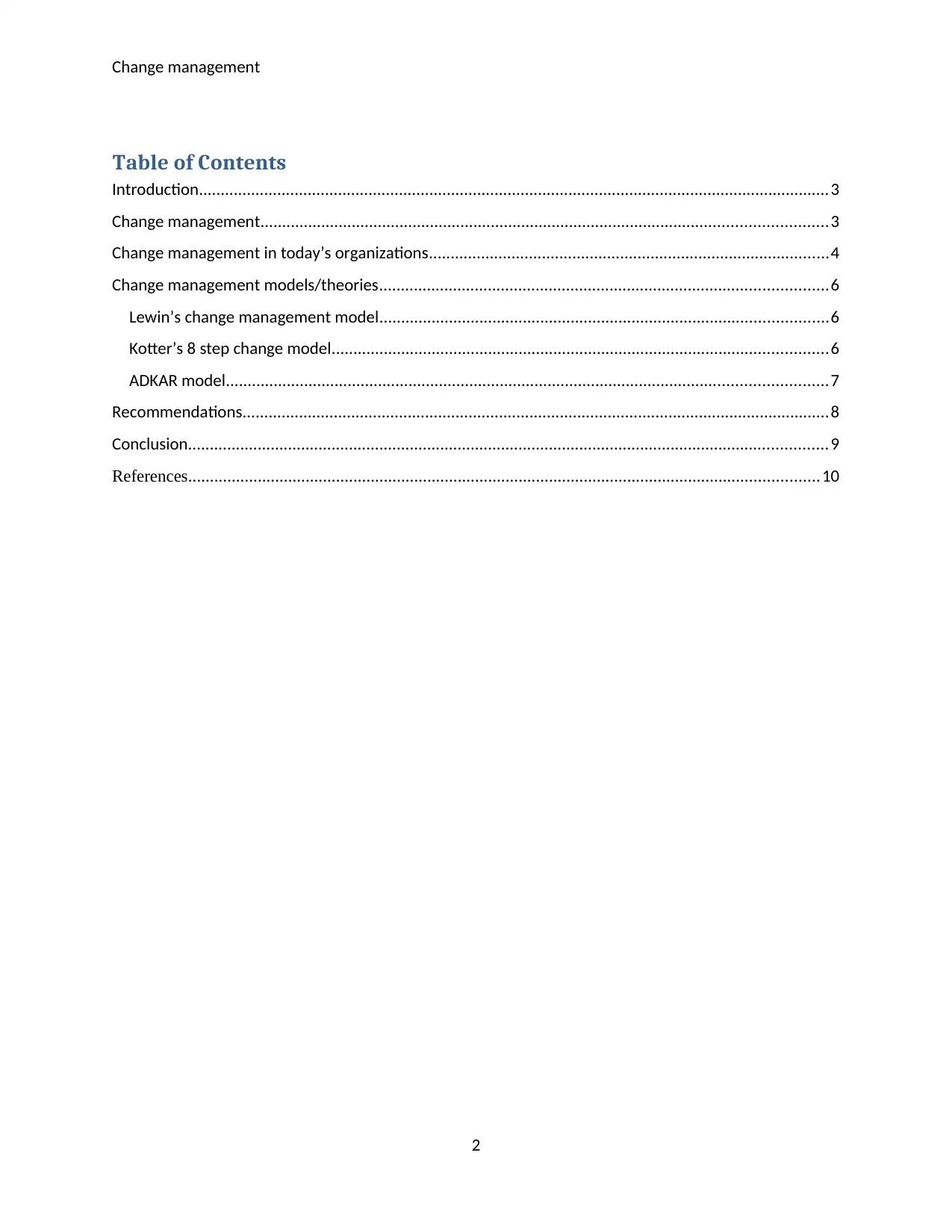
Change management
Table of Contents
Introduction.................................................................................................................................................3
Change management..................................................................................................................................3
Change management in today’s organizations............................................................................................4
Change management models/theories.......................................................................................................6
Lewin’s change management model.......................................................................................................6
Kotter’s 8 step change model..................................................................................................................6
ADKAR model..........................................................................................................................................7
Recommendations.......................................................................................................................................8
Conclusion...................................................................................................................................................9
References.................................................................................................................................................10
2
Table of Contents
Introduction.................................................................................................................................................3
Change management..................................................................................................................................3
Change management in today’s organizations............................................................................................4
Change management models/theories.......................................................................................................6
Lewin’s change management model.......................................................................................................6
Kotter’s 8 step change model..................................................................................................................6
ADKAR model..........................................................................................................................................7
Recommendations.......................................................................................................................................8
Conclusion...................................................................................................................................................9
References.................................................................................................................................................10
2
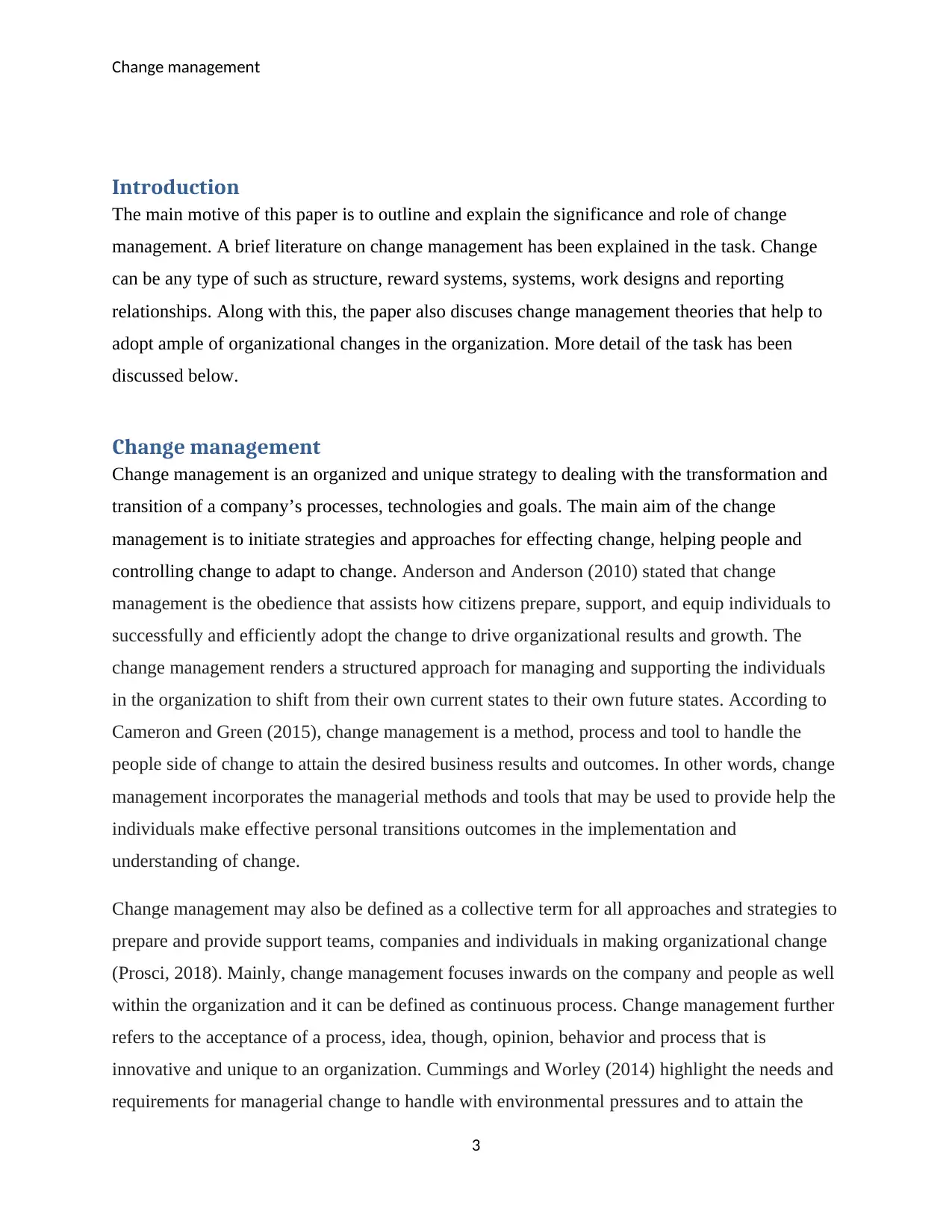
Change management
Introduction
The main motive of this paper is to outline and explain the significance and role of change
management. A brief literature on change management has been explained in the task. Change
can be any type of such as structure, reward systems, systems, work designs and reporting
relationships. Along with this, the paper also discuses change management theories that help to
adopt ample of organizational changes in the organization. More detail of the task has been
discussed below.
Change management
Change management is an organized and unique strategy to dealing with the transformation and
transition of a company’s processes, technologies and goals. The main aim of the change
management is to initiate strategies and approaches for effecting change, helping people and
controlling change to adapt to change. Anderson and Anderson (2010) stated that change
management is the obedience that assists how citizens prepare, support, and equip individuals to
successfully and efficiently adopt the change to drive organizational results and growth. The
change management renders a structured approach for managing and supporting the individuals
in the organization to shift from their own current states to their own future states. According to
Cameron and Green (2015), change management is a method, process and tool to handle the
people side of change to attain the desired business results and outcomes. In other words, change
management incorporates the managerial methods and tools that may be used to provide help the
individuals make effective personal transitions outcomes in the implementation and
understanding of change.
Change management may also be defined as a collective term for all approaches and strategies to
prepare and provide support teams, companies and individuals in making organizational change
(Prosci, 2018). Mainly, change management focuses inwards on the company and people as well
within the organization and it can be defined as continuous process. Change management further
refers to the acceptance of a process, idea, though, opinion, behavior and process that is
innovative and unique to an organization. Cummings and Worley (2014) highlight the needs and
requirements for managerial change to handle with environmental pressures and to attain the
3
Introduction
The main motive of this paper is to outline and explain the significance and role of change
management. A brief literature on change management has been explained in the task. Change
can be any type of such as structure, reward systems, systems, work designs and reporting
relationships. Along with this, the paper also discuses change management theories that help to
adopt ample of organizational changes in the organization. More detail of the task has been
discussed below.
Change management
Change management is an organized and unique strategy to dealing with the transformation and
transition of a company’s processes, technologies and goals. The main aim of the change
management is to initiate strategies and approaches for effecting change, helping people and
controlling change to adapt to change. Anderson and Anderson (2010) stated that change
management is the obedience that assists how citizens prepare, support, and equip individuals to
successfully and efficiently adopt the change to drive organizational results and growth. The
change management renders a structured approach for managing and supporting the individuals
in the organization to shift from their own current states to their own future states. According to
Cameron and Green (2015), change management is a method, process and tool to handle the
people side of change to attain the desired business results and outcomes. In other words, change
management incorporates the managerial methods and tools that may be used to provide help the
individuals make effective personal transitions outcomes in the implementation and
understanding of change.
Change management may also be defined as a collective term for all approaches and strategies to
prepare and provide support teams, companies and individuals in making organizational change
(Prosci, 2018). Mainly, change management focuses inwards on the company and people as well
within the organization and it can be defined as continuous process. Change management further
refers to the acceptance of a process, idea, though, opinion, behavior and process that is
innovative and unique to an organization. Cummings and Worley (2014) highlight the needs and
requirements for managerial change to handle with environmental pressures and to attain the
3
⊘ This is a preview!⊘
Do you want full access?
Subscribe today to unlock all pages.

Trusted by 1+ million students worldwide
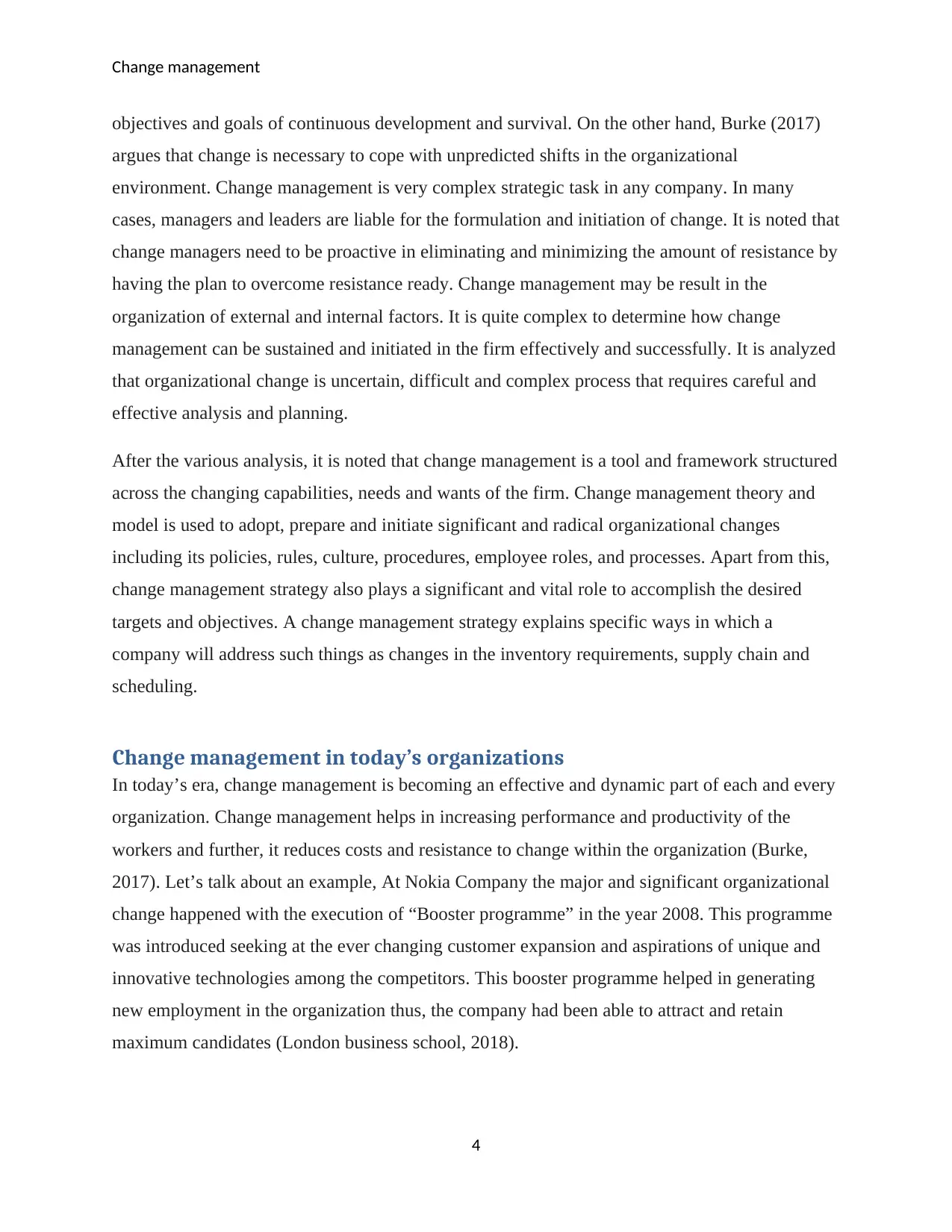
Change management
objectives and goals of continuous development and survival. On the other hand, Burke (2017)
argues that change is necessary to cope with unpredicted shifts in the organizational
environment. Change management is very complex strategic task in any company. In many
cases, managers and leaders are liable for the formulation and initiation of change. It is noted that
change managers need to be proactive in eliminating and minimizing the amount of resistance by
having the plan to overcome resistance ready. Change management may be result in the
organization of external and internal factors. It is quite complex to determine how change
management can be sustained and initiated in the firm effectively and successfully. It is analyzed
that organizational change is uncertain, difficult and complex process that requires careful and
effective analysis and planning.
After the various analysis, it is noted that change management is a tool and framework structured
across the changing capabilities, needs and wants of the firm. Change management theory and
model is used to adopt, prepare and initiate significant and radical organizational changes
including its policies, rules, culture, procedures, employee roles, and processes. Apart from this,
change management strategy also plays a significant and vital role to accomplish the desired
targets and objectives. A change management strategy explains specific ways in which a
company will address such things as changes in the inventory requirements, supply chain and
scheduling.
Change management in today’s organizations
In today’s era, change management is becoming an effective and dynamic part of each and every
organization. Change management helps in increasing performance and productivity of the
workers and further, it reduces costs and resistance to change within the organization (Burke,
2017). Let’s talk about an example, At Nokia Company the major and significant organizational
change happened with the execution of “Booster programme” in the year 2008. This programme
was introduced seeking at the ever changing customer expansion and aspirations of unique and
innovative technologies among the competitors. This booster programme helped in generating
new employment in the organization thus, the company had been able to attract and retain
maximum candidates (London business school, 2018).
4
objectives and goals of continuous development and survival. On the other hand, Burke (2017)
argues that change is necessary to cope with unpredicted shifts in the organizational
environment. Change management is very complex strategic task in any company. In many
cases, managers and leaders are liable for the formulation and initiation of change. It is noted that
change managers need to be proactive in eliminating and minimizing the amount of resistance by
having the plan to overcome resistance ready. Change management may be result in the
organization of external and internal factors. It is quite complex to determine how change
management can be sustained and initiated in the firm effectively and successfully. It is analyzed
that organizational change is uncertain, difficult and complex process that requires careful and
effective analysis and planning.
After the various analysis, it is noted that change management is a tool and framework structured
across the changing capabilities, needs and wants of the firm. Change management theory and
model is used to adopt, prepare and initiate significant and radical organizational changes
including its policies, rules, culture, procedures, employee roles, and processes. Apart from this,
change management strategy also plays a significant and vital role to accomplish the desired
targets and objectives. A change management strategy explains specific ways in which a
company will address such things as changes in the inventory requirements, supply chain and
scheduling.
Change management in today’s organizations
In today’s era, change management is becoming an effective and dynamic part of each and every
organization. Change management helps in increasing performance and productivity of the
workers and further, it reduces costs and resistance to change within the organization (Burke,
2017). Let’s talk about an example, At Nokia Company the major and significant organizational
change happened with the execution of “Booster programme” in the year 2008. This programme
was introduced seeking at the ever changing customer expansion and aspirations of unique and
innovative technologies among the competitors. This booster programme helped in generating
new employment in the organization thus, the company had been able to attract and retain
maximum candidates (London business school, 2018).
4
Paraphrase This Document
Need a fresh take? Get an instant paraphrase of this document with our AI Paraphraser
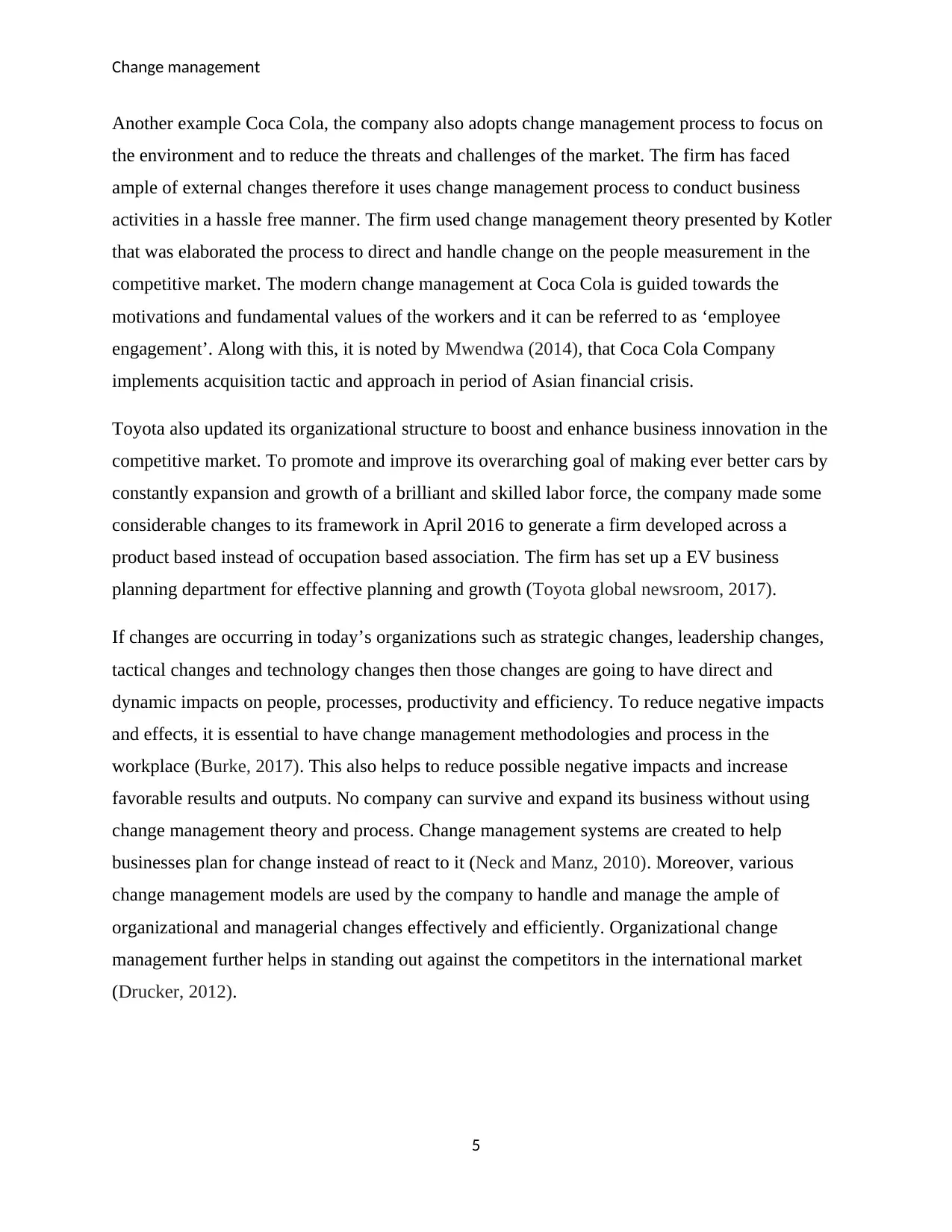
Change management
Another example Coca Cola, the company also adopts change management process to focus on
the environment and to reduce the threats and challenges of the market. The firm has faced
ample of external changes therefore it uses change management process to conduct business
activities in a hassle free manner. The firm used change management theory presented by Kotler
that was elaborated the process to direct and handle change on the people measurement in the
competitive market. The modern change management at Coca Cola is guided towards the
motivations and fundamental values of the workers and it can be referred to as ‘employee
engagement’. Along with this, it is noted by Mwendwa (2014), that Coca Cola Company
implements acquisition tactic and approach in period of Asian financial crisis.
Toyota also updated its organizational structure to boost and enhance business innovation in the
competitive market. To promote and improve its overarching goal of making ever better cars by
constantly expansion and growth of a brilliant and skilled labor force, the company made some
considerable changes to its framework in April 2016 to generate a firm developed across a
product based instead of occupation based association. The firm has set up a EV business
planning department for effective planning and growth (Toyota global newsroom, 2017).
If changes are occurring in today’s organizations such as strategic changes, leadership changes,
tactical changes and technology changes then those changes are going to have direct and
dynamic impacts on people, processes, productivity and efficiency. To reduce negative impacts
and effects, it is essential to have change management methodologies and process in the
workplace (Burke, 2017). This also helps to reduce possible negative impacts and increase
favorable results and outputs. No company can survive and expand its business without using
change management theory and process. Change management systems are created to help
businesses plan for change instead of react to it (Neck and Manz, 2010). Moreover, various
change management models are used by the company to handle and manage the ample of
organizational and managerial changes effectively and efficiently. Organizational change
management further helps in standing out against the competitors in the international market
(Drucker, 2012).
5
Another example Coca Cola, the company also adopts change management process to focus on
the environment and to reduce the threats and challenges of the market. The firm has faced
ample of external changes therefore it uses change management process to conduct business
activities in a hassle free manner. The firm used change management theory presented by Kotler
that was elaborated the process to direct and handle change on the people measurement in the
competitive market. The modern change management at Coca Cola is guided towards the
motivations and fundamental values of the workers and it can be referred to as ‘employee
engagement’. Along with this, it is noted by Mwendwa (2014), that Coca Cola Company
implements acquisition tactic and approach in period of Asian financial crisis.
Toyota also updated its organizational structure to boost and enhance business innovation in the
competitive market. To promote and improve its overarching goal of making ever better cars by
constantly expansion and growth of a brilliant and skilled labor force, the company made some
considerable changes to its framework in April 2016 to generate a firm developed across a
product based instead of occupation based association. The firm has set up a EV business
planning department for effective planning and growth (Toyota global newsroom, 2017).
If changes are occurring in today’s organizations such as strategic changes, leadership changes,
tactical changes and technology changes then those changes are going to have direct and
dynamic impacts on people, processes, productivity and efficiency. To reduce negative impacts
and effects, it is essential to have change management methodologies and process in the
workplace (Burke, 2017). This also helps to reduce possible negative impacts and increase
favorable results and outputs. No company can survive and expand its business without using
change management theory and process. Change management systems are created to help
businesses plan for change instead of react to it (Neck and Manz, 2010). Moreover, various
change management models are used by the company to handle and manage the ample of
organizational and managerial changes effectively and efficiently. Organizational change
management further helps in standing out against the competitors in the international market
(Drucker, 2012).
5
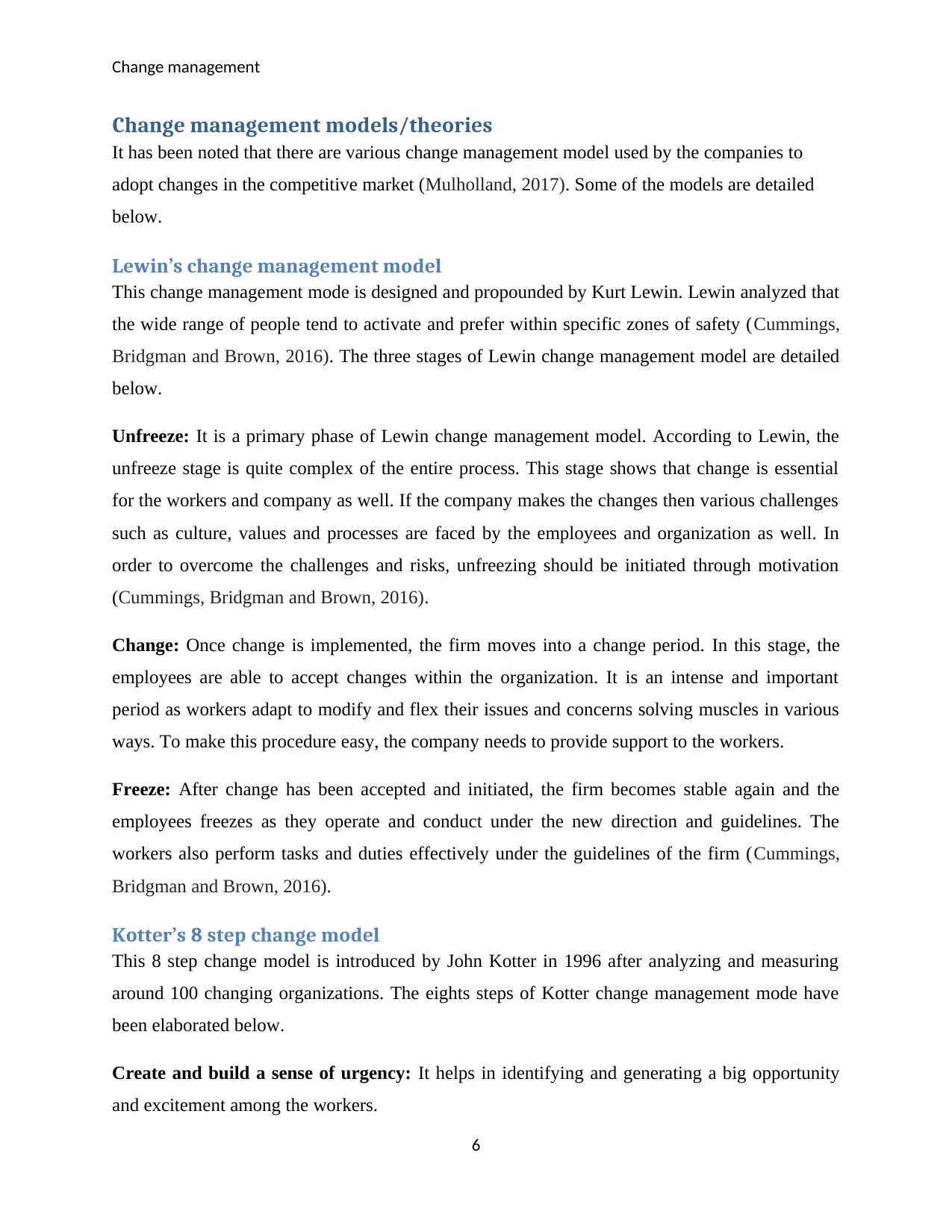
Change management
Change management models/theories
It has been noted that there are various change management model used by the companies to
adopt changes in the competitive market (Mulholland, 2017). Some of the models are detailed
below.
Lewin’s change management model
This change management mode is designed and propounded by Kurt Lewin. Lewin analyzed that
the wide range of people tend to activate and prefer within specific zones of safety (Cummings,
Bridgman and Brown, 2016). The three stages of Lewin change management model are detailed
below.
Unfreeze: It is a primary phase of Lewin change management model. According to Lewin, the
unfreeze stage is quite complex of the entire process. This stage shows that change is essential
for the workers and company as well. If the company makes the changes then various challenges
such as culture, values and processes are faced by the employees and organization as well. In
order to overcome the challenges and risks, unfreezing should be initiated through motivation
(Cummings, Bridgman and Brown, 2016).
Change: Once change is implemented, the firm moves into a change period. In this stage, the
employees are able to accept changes within the organization. It is an intense and important
period as workers adapt to modify and flex their issues and concerns solving muscles in various
ways. To make this procedure easy, the company needs to provide support to the workers.
Freeze: After change has been accepted and initiated, the firm becomes stable again and the
employees freezes as they operate and conduct under the new direction and guidelines. The
workers also perform tasks and duties effectively under the guidelines of the firm (Cummings,
Bridgman and Brown, 2016).
Kotter’s 8 step change model
This 8 step change model is introduced by John Kotter in 1996 after analyzing and measuring
around 100 changing organizations. The eights steps of Kotter change management mode have
been elaborated below.
Create and build a sense of urgency: It helps in identifying and generating a big opportunity
and excitement among the workers.
6
Change management models/theories
It has been noted that there are various change management model used by the companies to
adopt changes in the competitive market (Mulholland, 2017). Some of the models are detailed
below.
Lewin’s change management model
This change management mode is designed and propounded by Kurt Lewin. Lewin analyzed that
the wide range of people tend to activate and prefer within specific zones of safety (Cummings,
Bridgman and Brown, 2016). The three stages of Lewin change management model are detailed
below.
Unfreeze: It is a primary phase of Lewin change management model. According to Lewin, the
unfreeze stage is quite complex of the entire process. This stage shows that change is essential
for the workers and company as well. If the company makes the changes then various challenges
such as culture, values and processes are faced by the employees and organization as well. In
order to overcome the challenges and risks, unfreezing should be initiated through motivation
(Cummings, Bridgman and Brown, 2016).
Change: Once change is implemented, the firm moves into a change period. In this stage, the
employees are able to accept changes within the organization. It is an intense and important
period as workers adapt to modify and flex their issues and concerns solving muscles in various
ways. To make this procedure easy, the company needs to provide support to the workers.
Freeze: After change has been accepted and initiated, the firm becomes stable again and the
employees freezes as they operate and conduct under the new direction and guidelines. The
workers also perform tasks and duties effectively under the guidelines of the firm (Cummings,
Bridgman and Brown, 2016).
Kotter’s 8 step change model
This 8 step change model is introduced by John Kotter in 1996 after analyzing and measuring
around 100 changing organizations. The eights steps of Kotter change management mode have
been elaborated below.
Create and build a sense of urgency: It helps in identifying and generating a big opportunity
and excitement among the workers.
6
⊘ This is a preview!⊘
Do you want full access?
Subscribe today to unlock all pages.

Trusted by 1+ million students worldwide
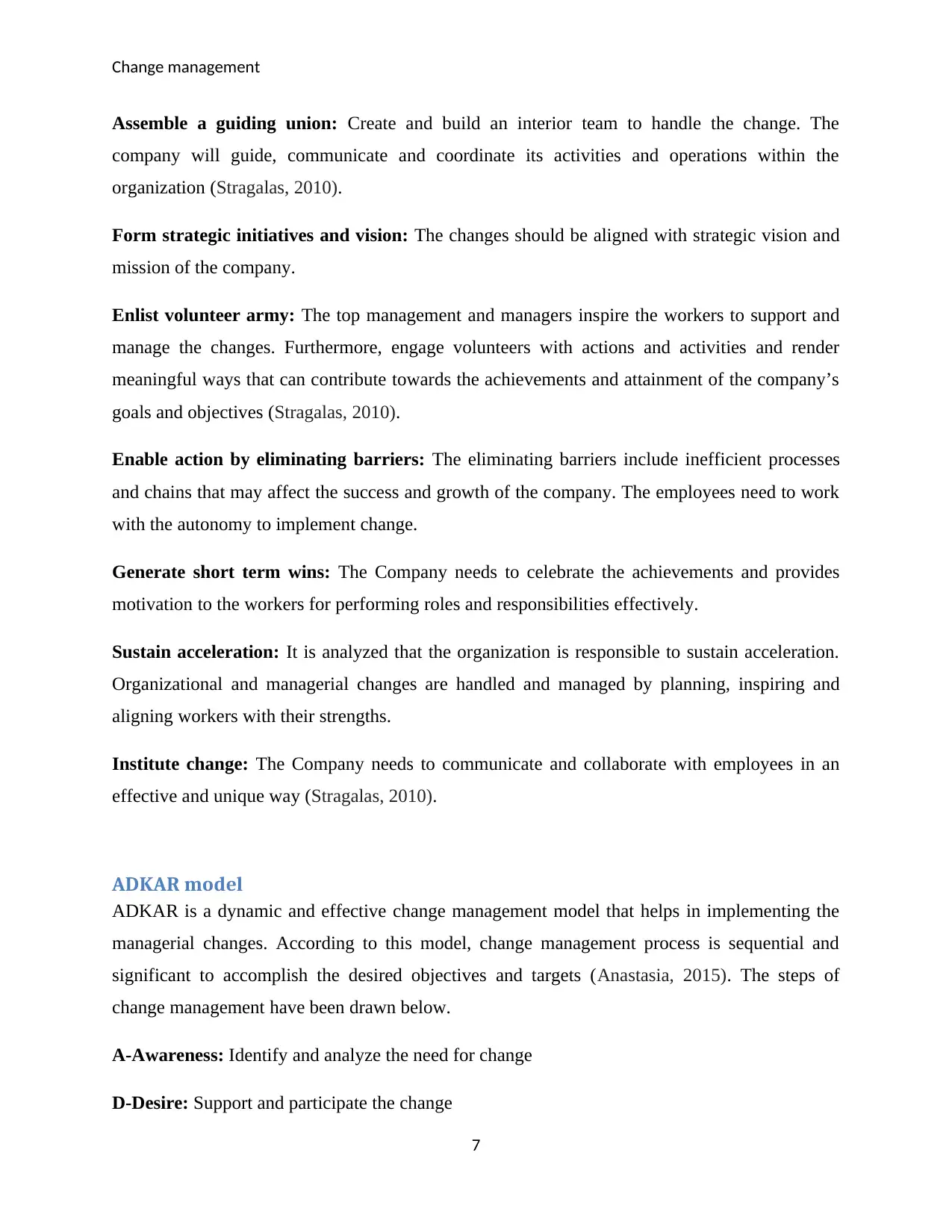
Change management
Assemble a guiding union: Create and build an interior team to handle the change. The
company will guide, communicate and coordinate its activities and operations within the
organization (Stragalas, 2010).
Form strategic initiatives and vision: The changes should be aligned with strategic vision and
mission of the company.
Enlist volunteer army: The top management and managers inspire the workers to support and
manage the changes. Furthermore, engage volunteers with actions and activities and render
meaningful ways that can contribute towards the achievements and attainment of the company’s
goals and objectives (Stragalas, 2010).
Enable action by eliminating barriers: The eliminating barriers include inefficient processes
and chains that may affect the success and growth of the company. The employees need to work
with the autonomy to implement change.
Generate short term wins: The Company needs to celebrate the achievements and provides
motivation to the workers for performing roles and responsibilities effectively.
Sustain acceleration: It is analyzed that the organization is responsible to sustain acceleration.
Organizational and managerial changes are handled and managed by planning, inspiring and
aligning workers with their strengths.
Institute change: The Company needs to communicate and collaborate with employees in an
effective and unique way (Stragalas, 2010).
ADKAR model
ADKAR is a dynamic and effective change management model that helps in implementing the
managerial changes. According to this model, change management process is sequential and
significant to accomplish the desired objectives and targets (Anastasia, 2015). The steps of
change management have been drawn below.
A-Awareness: Identify and analyze the need for change
D-Desire: Support and participate the change
7
Assemble a guiding union: Create and build an interior team to handle the change. The
company will guide, communicate and coordinate its activities and operations within the
organization (Stragalas, 2010).
Form strategic initiatives and vision: The changes should be aligned with strategic vision and
mission of the company.
Enlist volunteer army: The top management and managers inspire the workers to support and
manage the changes. Furthermore, engage volunteers with actions and activities and render
meaningful ways that can contribute towards the achievements and attainment of the company’s
goals and objectives (Stragalas, 2010).
Enable action by eliminating barriers: The eliminating barriers include inefficient processes
and chains that may affect the success and growth of the company. The employees need to work
with the autonomy to implement change.
Generate short term wins: The Company needs to celebrate the achievements and provides
motivation to the workers for performing roles and responsibilities effectively.
Sustain acceleration: It is analyzed that the organization is responsible to sustain acceleration.
Organizational and managerial changes are handled and managed by planning, inspiring and
aligning workers with their strengths.
Institute change: The Company needs to communicate and collaborate with employees in an
effective and unique way (Stragalas, 2010).
ADKAR model
ADKAR is a dynamic and effective change management model that helps in implementing the
managerial changes. According to this model, change management process is sequential and
significant to accomplish the desired objectives and targets (Anastasia, 2015). The steps of
change management have been drawn below.
A-Awareness: Identify and analyze the need for change
D-Desire: Support and participate the change
7
Paraphrase This Document
Need a fresh take? Get an instant paraphrase of this document with our AI Paraphraser
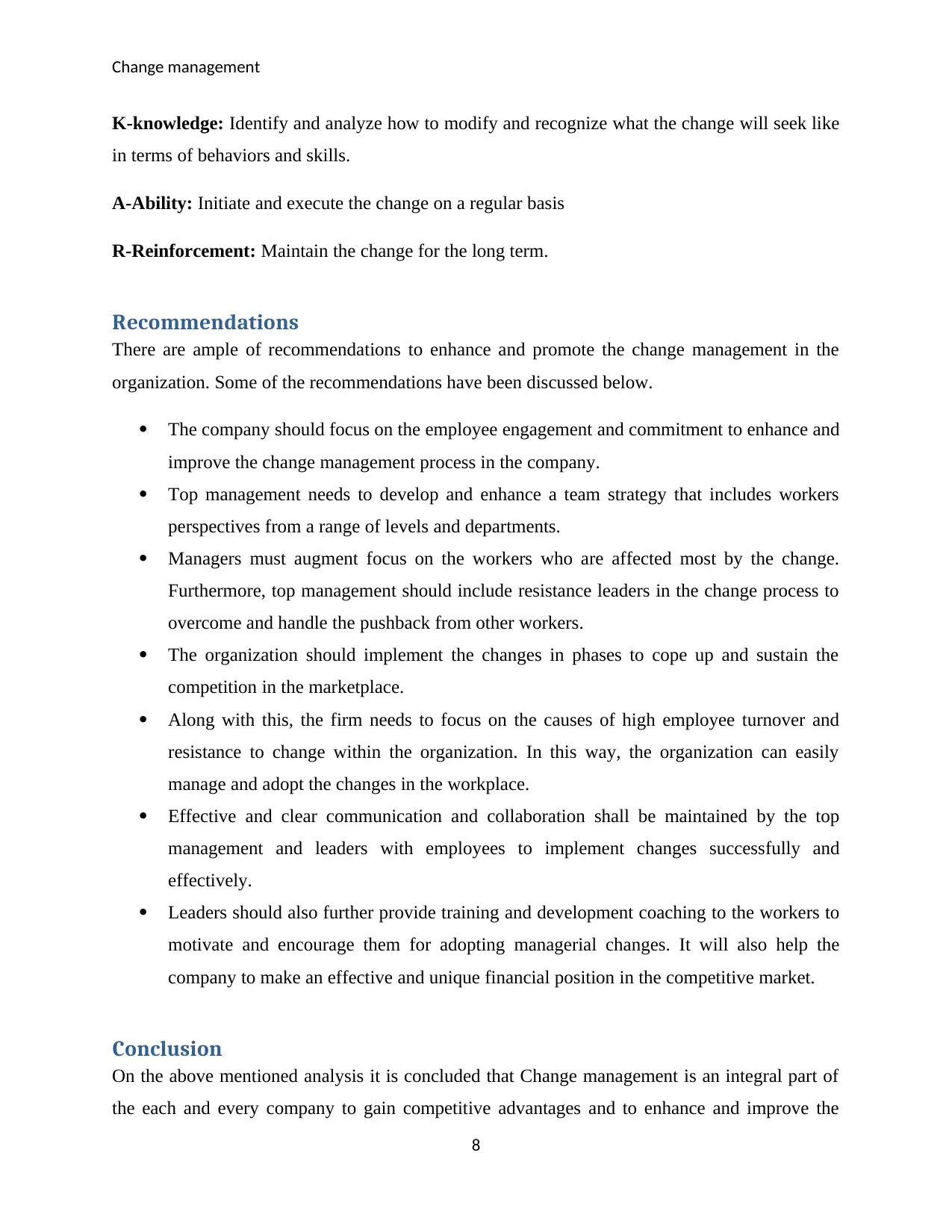
Change management
K-knowledge: Identify and analyze how to modify and recognize what the change will seek like
in terms of behaviors and skills.
A-Ability: Initiate and execute the change on a regular basis
R-Reinforcement: Maintain the change for the long term.
Recommendations
There are ample of recommendations to enhance and promote the change management in the
organization. Some of the recommendations have been discussed below.
The company should focus on the employee engagement and commitment to enhance and
improve the change management process in the company.
Top management needs to develop and enhance a team strategy that includes workers
perspectives from a range of levels and departments.
Managers must augment focus on the workers who are affected most by the change.
Furthermore, top management should include resistance leaders in the change process to
overcome and handle the pushback from other workers.
The organization should implement the changes in phases to cope up and sustain the
competition in the marketplace.
Along with this, the firm needs to focus on the causes of high employee turnover and
resistance to change within the organization. In this way, the organization can easily
manage and adopt the changes in the workplace.
Effective and clear communication and collaboration shall be maintained by the top
management and leaders with employees to implement changes successfully and
effectively.
Leaders should also further provide training and development coaching to the workers to
motivate and encourage them for adopting managerial changes. It will also help the
company to make an effective and unique financial position in the competitive market.
Conclusion
On the above mentioned analysis it is concluded that Change management is an integral part of
the each and every company to gain competitive advantages and to enhance and improve the
8
K-knowledge: Identify and analyze how to modify and recognize what the change will seek like
in terms of behaviors and skills.
A-Ability: Initiate and execute the change on a regular basis
R-Reinforcement: Maintain the change for the long term.
Recommendations
There are ample of recommendations to enhance and promote the change management in the
organization. Some of the recommendations have been discussed below.
The company should focus on the employee engagement and commitment to enhance and
improve the change management process in the company.
Top management needs to develop and enhance a team strategy that includes workers
perspectives from a range of levels and departments.
Managers must augment focus on the workers who are affected most by the change.
Furthermore, top management should include resistance leaders in the change process to
overcome and handle the pushback from other workers.
The organization should implement the changes in phases to cope up and sustain the
competition in the marketplace.
Along with this, the firm needs to focus on the causes of high employee turnover and
resistance to change within the organization. In this way, the organization can easily
manage and adopt the changes in the workplace.
Effective and clear communication and collaboration shall be maintained by the top
management and leaders with employees to implement changes successfully and
effectively.
Leaders should also further provide training and development coaching to the workers to
motivate and encourage them for adopting managerial changes. It will also help the
company to make an effective and unique financial position in the competitive market.
Conclusion
On the above mentioned analysis it is concluded that Change management is an integral part of
the each and every company to gain competitive advantages and to enhance and improve the
8
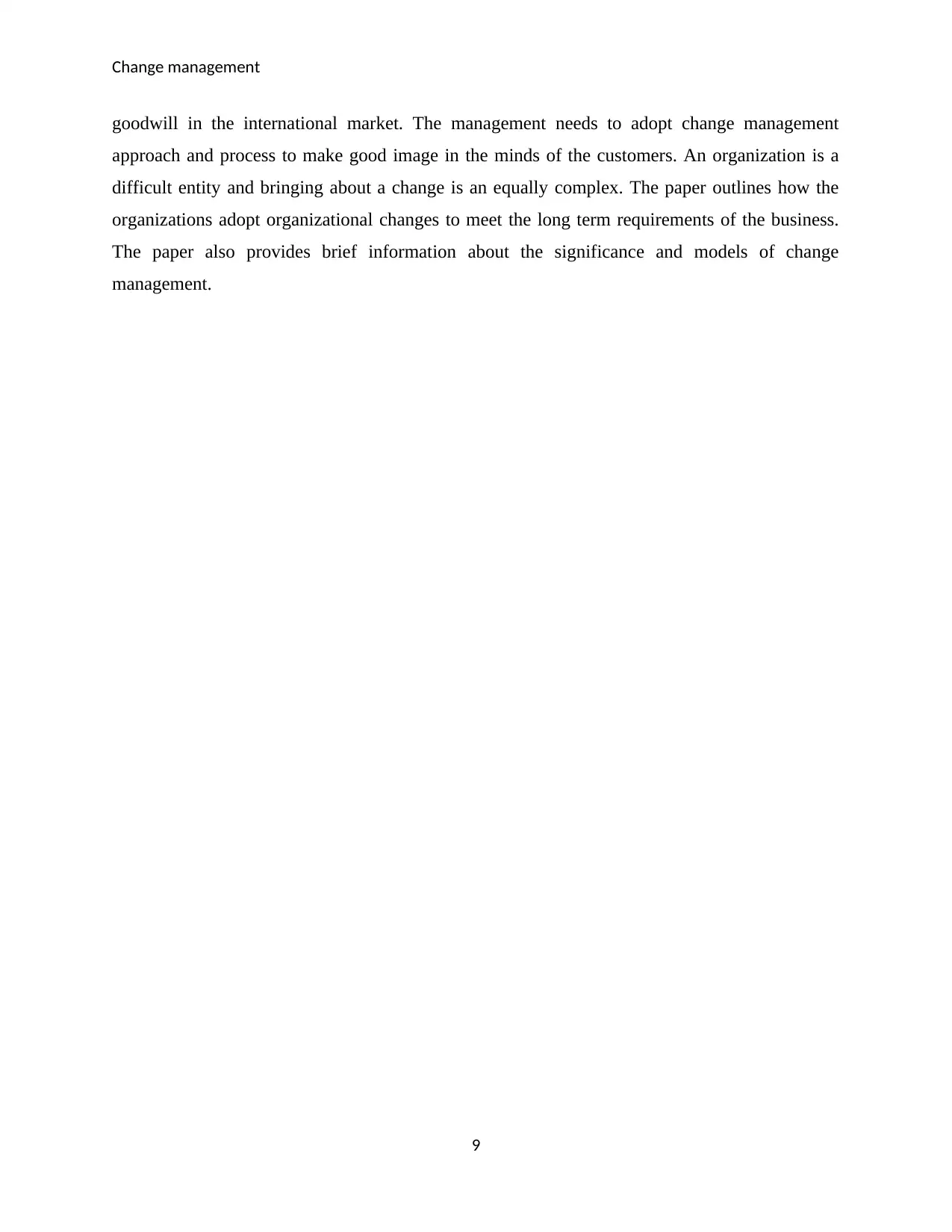
Change management
goodwill in the international market. The management needs to adopt change management
approach and process to make good image in the minds of the customers. An organization is a
difficult entity and bringing about a change is an equally complex. The paper outlines how the
organizations adopt organizational changes to meet the long term requirements of the business.
The paper also provides brief information about the significance and models of change
management.
9
goodwill in the international market. The management needs to adopt change management
approach and process to make good image in the minds of the customers. An organization is a
difficult entity and bringing about a change is an equally complex. The paper outlines how the
organizations adopt organizational changes to meet the long term requirements of the business.
The paper also provides brief information about the significance and models of change
management.
9
⊘ This is a preview!⊘
Do you want full access?
Subscribe today to unlock all pages.

Trusted by 1+ million students worldwide
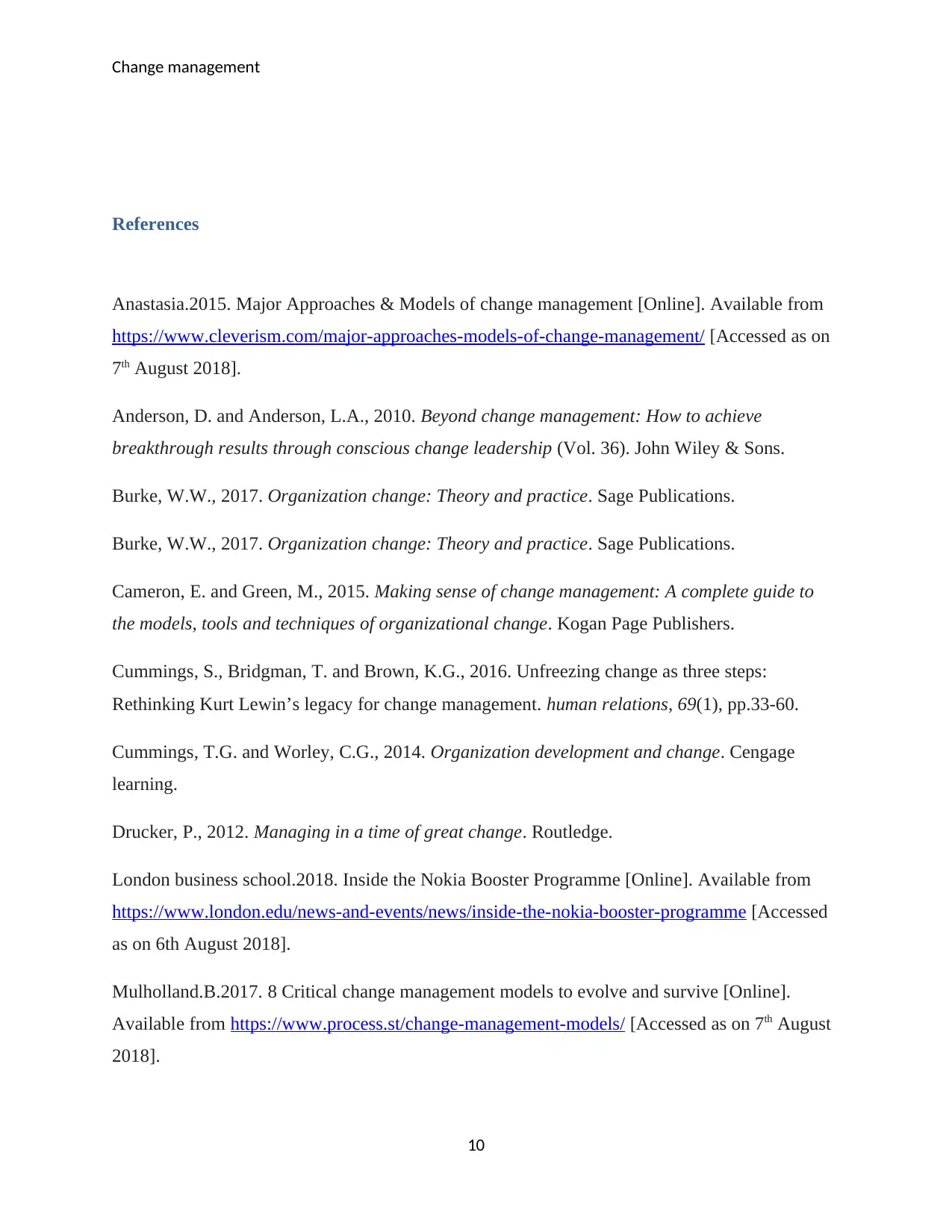
Change management
References
Anastasia.2015. Major Approaches & Models of change management [Online]. Available from
https://www.cleverism.com/major-approaches-models-of-change-management/ [Accessed as on
7th August 2018].
Anderson, D. and Anderson, L.A., 2010. Beyond change management: How to achieve
breakthrough results through conscious change leadership (Vol. 36). John Wiley & Sons.
Burke, W.W., 2017. Organization change: Theory and practice. Sage Publications.
Burke, W.W., 2017. Organization change: Theory and practice. Sage Publications.
Cameron, E. and Green, M., 2015. Making sense of change management: A complete guide to
the models, tools and techniques of organizational change. Kogan Page Publishers.
Cummings, S., Bridgman, T. and Brown, K.G., 2016. Unfreezing change as three steps:
Rethinking Kurt Lewin’s legacy for change management. human relations, 69(1), pp.33-60.
Cummings, T.G. and Worley, C.G., 2014. Organization development and change. Cengage
learning.
Drucker, P., 2012. Managing in a time of great change. Routledge.
London business school.2018. Inside the Nokia Booster Programme [Online]. Available from
https://www.london.edu/news-and-events/news/inside-the-nokia-booster-programme [Accessed
as on 6th August 2018].
Mulholland.B.2017. 8 Critical change management models to evolve and survive [Online].
Available from https://www.process.st/change-management-models/ [Accessed as on 7th August
2018].
10
References
Anastasia.2015. Major Approaches & Models of change management [Online]. Available from
https://www.cleverism.com/major-approaches-models-of-change-management/ [Accessed as on
7th August 2018].
Anderson, D. and Anderson, L.A., 2010. Beyond change management: How to achieve
breakthrough results through conscious change leadership (Vol. 36). John Wiley & Sons.
Burke, W.W., 2017. Organization change: Theory and practice. Sage Publications.
Burke, W.W., 2017. Organization change: Theory and practice. Sage Publications.
Cameron, E. and Green, M., 2015. Making sense of change management: A complete guide to
the models, tools and techniques of organizational change. Kogan Page Publishers.
Cummings, S., Bridgman, T. and Brown, K.G., 2016. Unfreezing change as three steps:
Rethinking Kurt Lewin’s legacy for change management. human relations, 69(1), pp.33-60.
Cummings, T.G. and Worley, C.G., 2014. Organization development and change. Cengage
learning.
Drucker, P., 2012. Managing in a time of great change. Routledge.
London business school.2018. Inside the Nokia Booster Programme [Online]. Available from
https://www.london.edu/news-and-events/news/inside-the-nokia-booster-programme [Accessed
as on 6th August 2018].
Mulholland.B.2017. 8 Critical change management models to evolve and survive [Online].
Available from https://www.process.st/change-management-models/ [Accessed as on 7th August
2018].
10
Paraphrase This Document
Need a fresh take? Get an instant paraphrase of this document with our AI Paraphraser
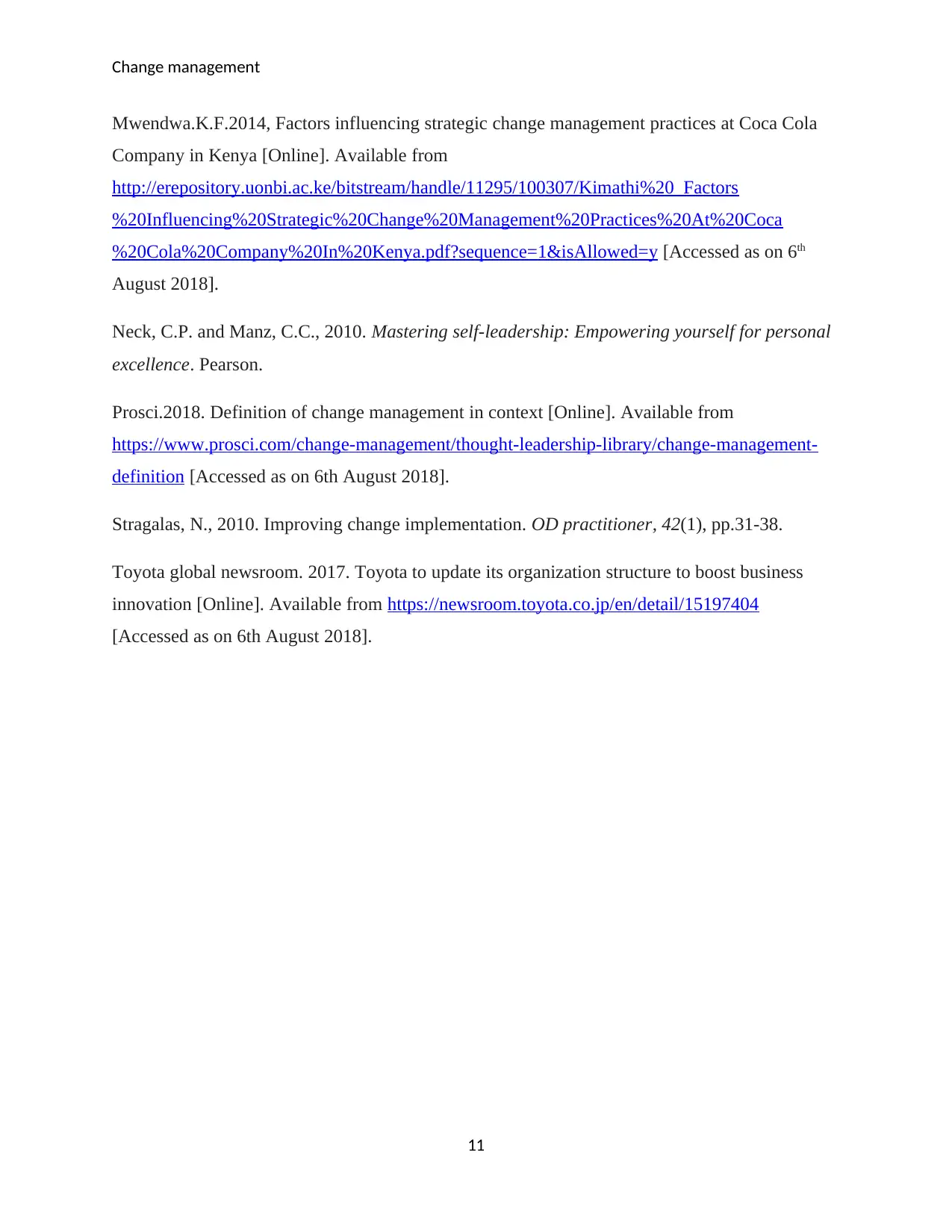
Change management
Mwendwa.K.F.2014, Factors influencing strategic change management practices at Coca Cola
Company in Kenya [Online]. Available from
http://erepository.uonbi.ac.ke/bitstream/handle/11295/100307/Kimathi%20_Factors
%20Influencing%20Strategic%20Change%20Management%20Practices%20At%20Coca
%20Cola%20Company%20In%20Kenya.pdf?sequence=1&isAllowed=y [Accessed as on 6th
August 2018].
Neck, C.P. and Manz, C.C., 2010. Mastering self-leadership: Empowering yourself for personal
excellence. Pearson.
Prosci.2018. Definition of change management in context [Online]. Available from
https://www.prosci.com/change-management/thought-leadership-library/change-management-
definition [Accessed as on 6th August 2018].
Stragalas, N., 2010. Improving change implementation. OD practitioner, 42(1), pp.31-38.
Toyota global newsroom. 2017. Toyota to update its organization structure to boost business
innovation [Online]. Available from https://newsroom.toyota.co.jp/en/detail/15197404
[Accessed as on 6th August 2018].
11
Mwendwa.K.F.2014, Factors influencing strategic change management practices at Coca Cola
Company in Kenya [Online]. Available from
http://erepository.uonbi.ac.ke/bitstream/handle/11295/100307/Kimathi%20_Factors
%20Influencing%20Strategic%20Change%20Management%20Practices%20At%20Coca
%20Cola%20Company%20In%20Kenya.pdf?sequence=1&isAllowed=y [Accessed as on 6th
August 2018].
Neck, C.P. and Manz, C.C., 2010. Mastering self-leadership: Empowering yourself for personal
excellence. Pearson.
Prosci.2018. Definition of change management in context [Online]. Available from
https://www.prosci.com/change-management/thought-leadership-library/change-management-
definition [Accessed as on 6th August 2018].
Stragalas, N., 2010. Improving change implementation. OD practitioner, 42(1), pp.31-38.
Toyota global newsroom. 2017. Toyota to update its organization structure to boost business
innovation [Online]. Available from https://newsroom.toyota.co.jp/en/detail/15197404
[Accessed as on 6th August 2018].
11
1 out of 11
Related Documents
Your All-in-One AI-Powered Toolkit for Academic Success.
+13062052269
info@desklib.com
Available 24*7 on WhatsApp / Email
![[object Object]](/_next/static/media/star-bottom.7253800d.svg)
Unlock your academic potential
Copyright © 2020–2025 A2Z Services. All Rights Reserved. Developed and managed by ZUCOL.




